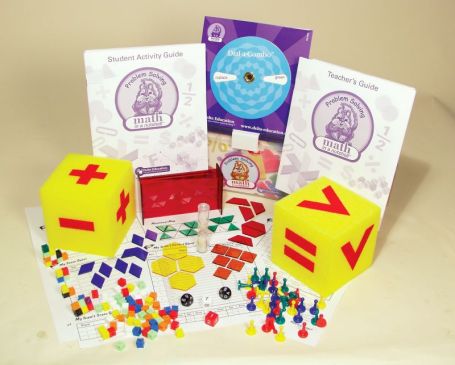Archive for February, 2014
Math in a Nutshell: Problem Solving Strategies
 Here’s a quick lesson from Delta Education’s Math in a Nutshell: Problem Solving kit to help students learn good problem solving strategies. We’ve included a student worksheet PDF for copying.
Here’s a quick lesson from Delta Education’s Math in a Nutshell: Problem Solving kit to help students learn good problem solving strategies. We’ve included a student worksheet PDF for copying.
In a NUTSHELL, good problem solvers use these strategies:
- Read the problem carefully
- Look for important information
- Think about the question being asked
- Make a model and/or draw pictures
TEACHING SUGGESTIONS
- Review the concepts of a rectangle, area of a surface, and base, such as you might find in a set of steps. Students should explore table tops and desks for models. Be sure they know how to use square units for area.
- Encourage students to plan and discuss methods for building models and drawing representations before beginning to solve the problems.
- Remind students that they should label drawings. Draw a sample rectangle for them and label the sides to show its measurements.
SAMPLE ACTIVITY
 Materials needed:
Materials needed:
Centimeter cubes
Read the problem carefully.
Sheila wants to make a floor in the kitchen of her younger sister’s play house using centimeter cubes. The floor is a rectangle. Two opposite sides are 5 cm each (the width). The other two sides are 4 cm each (the length). How many cubes in all does she need to cover the area of the whole kitchen floor?
Look for important information.
- rectangle
- 5 cm and 4 cm
Think about the question.
- How many in all?
- Cover the area of the whole floor
“Show” the problem: Build a model or draw a picture.
- Use cm cubes to build a model of the floor. Use any colors, but make sure there are 5 cubes on two sides and 4 cubes on the other two sides.
- Connect the cubes; then use them to fill the rectangle.
- Count the cubes. How many are needed to cover the floor? ___________________
- What’s another way you could get the same total using 4 cm and 5 cm without counting each cube? _____________________
ANSWER
After counting the cubes, the answer should be 20. Colored rectangles should accurately depict the model. Another way to get the same total is to multiply 4×5.
STUDENT CHALLENGE
Using this downloadable PDF Worksheet, have students work in teams to solve a similar problem. Their drawing should show a rectangle 7 cm x 5 cm. Some children may use squares to represent the cubes. Sides in the drawing should be labeled, and students should indicate that the answer is 35 cubes, or tiles. Explanations about finding area will vary. Possible answer: You can find the area of a rectangle by making a model out of centimeter cubes or by multiplying the length times the width.
DISCUSSION POINTS
- How are models and drawings helpful in solving some problems? Possible answer: They give you something you can touch or see that helps you understand the problem and its solution.
- What other problem-solving strategies do you think work well with building models and drawing pictures? Why? Answers will vary. Possible answers: The strategy of reading the problem carefully and thinking about what the problem is asking works well with building models and drawing pictures because it helps guide you or give you a plan for how the model needs to look. Guess and check is also helpful because you may have to try building the model or drawing the pictures several ways before you can come up with a correct answer.
Additional activities featured in the Math in a Nutshell: Problem Solving kit include:
- Guess and Check It – applying “guess and check” strategies to new problems, performing 2-step operations
- Organize It – understanding relationships, analyzing characteristics and properties, using patterns to classify and organize, applying organizational strategies
- Equate It – using information in story problems to form equations, using multiple equations to solve problems
- Analyze It – organizing data, applying analytical strategies to solve new problems
- Operate It – selecting operations to solve problems, developing fluency in adding, subtracting, multiplying, and dividing to find answers to problems
- Solve It – selecting and applying appropriate problem-solving strategies
Each Nutshell includes:
- 32+ page Student Activity Guide with reproducible pages and performance assessment
- 24-page Teacher Guide with student answers, extensions, and correlations to NCTM standards
- 7 game-based activities
- Engaging and durable materials for up to 4 students
- Unique manipulatives offered only by Delta Education
★ Get an email notification when we post a new lesson or sweepstakes.
Enter email address in “Follow Blog via Email” section of sidebar. ★

